Case Studies
Industries
Resources
Ratings & Reviews
NEW
Shopping is, was and always will be a social experience. No wonder so many new social shopping trends have invaded the ecommerce universe in recent years.
Think about it. From the past decades dominated by shopping malls and department stores to the modern era of eCommerce, the social aspect of shopping is here to stay.
In fact, the social nature of shopping is perhaps more relevant than ever as social media and eCommerce now go hand-in-hand.
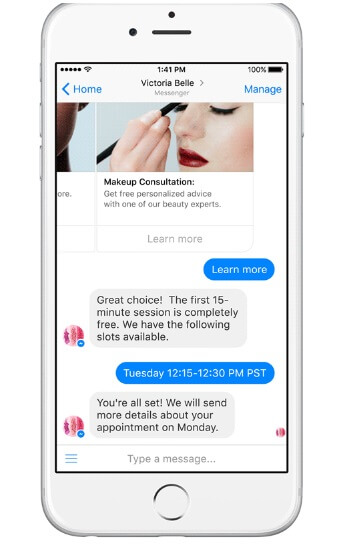
The rise social shopping for eCommerce has been a long time coming; however, the extent to which modern customers rely on social media and follower feedback for their recent purchases is rather staggering:
According to Podium, over 93% of consumers say online reviews have an impact on their purchase decision, today’s customers are on the hunt for positive social comments and star-ratings from real people before they make a purchase
82% of consumers say the content of a review has convinced them to make a purchase
Brands offering stellar service via social are 71% more likely to have their products recommended to others
The number of consumers reading reviews, making recommendations and using social media to engage with products is at an all-time high. As a result, more brands are expected to integrate social media into their websites and marketing campaigns to reach these customers accordingly.
But is it integration enough by itself?
Recent social shopping trends signal otherwise.
After all, the uphill battle for brands is not only to sell through social media, but also ensure that existing customers and future prospects become long-term followers.
The key goals of social shopping are to encourage more purchases via social and create evangelists who are willing to back up your brand time and time again. However, encouraging social shopping is somewhat of a balancing act: the trick is driving social purchases without spamming your followers and prospects.
Fortunately, smart marketing techniques have emerged for eCommerce giants and budding brands alike. The following social shopping trends are fair game for any business as the eCommerce space continues to evolve in favor of socially-driven brands.
The explosion of Facebook’s Messenger has opened the floodgates for brands looking to get in front of their followings. Marketing via Messenger is no longer uncharted territory as Facebook acknowledges the potential of messenger-based marketing including:
Messenger’s massive reach of well over 1.3 billion active monthly users
Ads via Messenger don’t require any sort of opt-in process (think: email marketing) or the installation of a native app to reach followers
Notably high open-rates: although the often-spouted 98% open-rate may be exaggerated, there’s no denying that direct messages are more likely to be seen versus emails

Considering how robust Facebook’s advertising platform is already, Messenger marketing offers a new layer of reach that quite literally puts brands into the pockets of their prospects.
Advertising via social represents as many challenges to brands as it does opportunities.
Sure, social platforms allow conversations with followers instead of talking at them; however, who’s going to run the show?
And yes, you can monitor and meet the needs of customers in real-time, but do you have the bandwidth to address these concerns at a moment’s notice?
As a result, a new wave of chatbots has emerged to automate these processes and remove the need for dedicated social monitors.
Traditionally speaking, chatbots have been around to handle simple commands (think: “yes” or “no” queries) on behalf of customers, acting akin to an automated phone service.
Although the concept of chatbots isn’t particularly groundbreaking by themselves, the degree in which artificial intelligence is evolving to learn customer behavior is of particular interest to eCommerce brands. Integrating with built-in messenger apps such as Facebook and KiK, these bots offer new layers of engagement and personalization for shoppers. Check out Nordstrom’s chatbot in action:
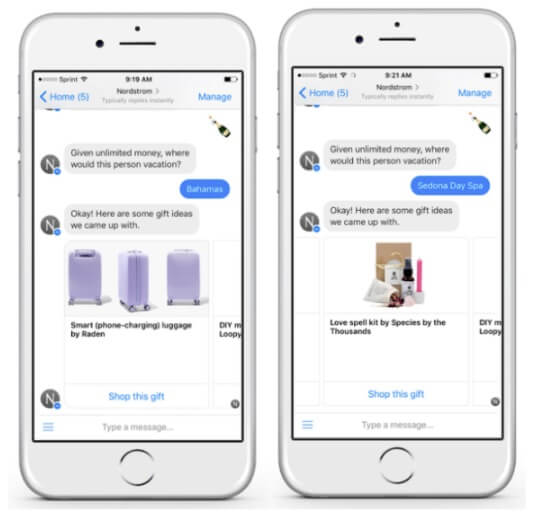
In short, chatbots act as digital attendants for shoppers looking in search of recommendations. More advanced bots can essentially “learn” the preferences of customers based on past behavior and suggest products accordingly.
While at a glance such technology seems like antisocial shopping, bear in mind that the ability to “get to know” customers represents a fresh take on personalization. By having bots essentially deliver products directly, brands make life easier for customers uninterested in the process of sifting through product pages. Considering that 56% of shoppers are more likely to return to a brand that recommends products, chatbots do the heavy lifting on behalf of brands looking to recommend products.
As an added bonus, chatbots do not require the installation of a native app and like any other form of messenger marketing, ends up right in a customers’ inbox. Although the technology is changing rapidly, the fact that fashion giants such as H&M, Tommy Hilfiger and the aforementioned Nordstrom are on board is rather telling, isn’t it?
Of course, naysayers may claim that chatbots are a step backward in the era of social shopping. That being said, savvy chatbots keep the human element intact through laid-back language and intuitive recommendations. Check out the tone of H&M’s chatbot, whose autoresponders definitely sound akin to that of a real-life representative:
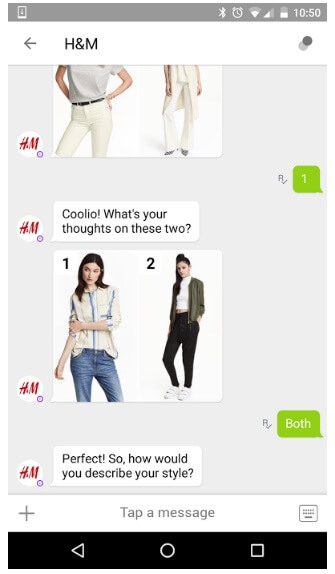
Whether or not such bots become commonplace for smaller businesses remains to be seen. Regardless, brands and consumers alike should keep a close eye on chatbots as one the most notable social shopping trends to evolve over the course of the next year or so.
Quizzes may seem like little more than novelties that pop up in our social feeds from time to time.

However, quizzes boast surprisingly high conversion rates and are a time-tested tool for encouraging audience engagement. Half the fun of those cheesy “Which Game of Thrones Characters Are You?” quizzes that dominate Facebook is comparing your results with your friends, right? As a result, clever eCommerce brands are using the social, shareable aspect of quizzes to their advantage.
Among the social shopping trends noted in this post, quizzes are perhaps the most diverse in terms of what they can accomplish. In addition to encouraging likes, shares and opt-ins, quizzes may be used to personalize the shopping experience in the case of fashion brands.
Check out Topshop’s style quiz which encourages users to figure out their ideal style based on their products and shop recommendations accordingly:
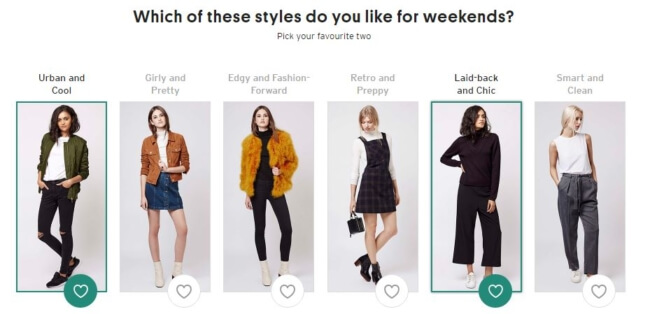
Not unlike the aforementioned chatbots, this particular quiz acts as a sort of fashion consultant to help quiz-takers find the best fits. The quiz goes into details such as height and weight to help find the ideal pieces and personalize the shopping experience. Prior to your results, Topshop provides a brief opt-in form:
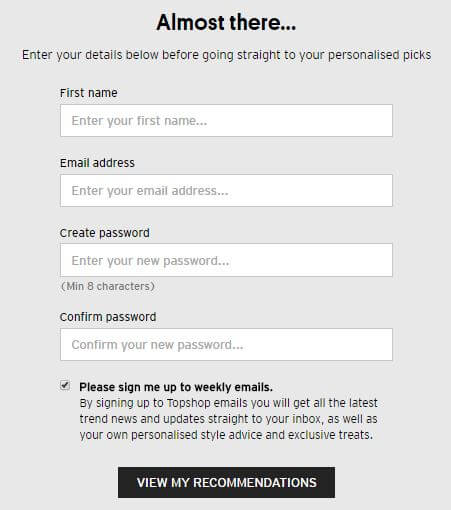
The results are provided both on-site and via email alongside a free shipping code and product recommendations. Note the social share buttons which encourage spreading the quiz around:

The beauty of quizzes is two-fold: they are completely customizable and don’t come off as salesy whatsoever. The latter increases their sharing potential and offers a playful alternative to marketers looking to get to know the prospects. Through quizzes, brands can gather information on their customers and make an emotional connection simultaneously.
It’s well-documented that the more steps you put between your prospects and the checkout counter, the more likely they are to fall out of your funnel. This rings true in the case of opt-in forms and any other marketing funnel that requires customers to go through a bunch of tedious steps.
Social shopping trends such as one-click purchasing represent a simple, unobtrusive strategy for marketers to keep their leads from bouncing and ultimately make buying a breeze. This is especially important for brands with a large percentage of mobile users who thrive on checkouts with minimalist design. Since Amazon’s patent on one-click purchasing has expired, more brands have hopped on board through platforms such as Stripe.
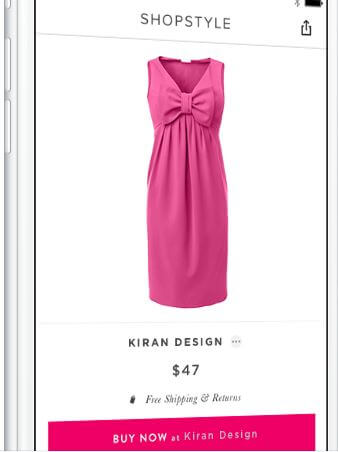
On a similar note, social logins represent a savvy way to encourage on-site registration and shopping without leaving the page. Allowing customers to sign-in via social represent a prime way to keep visitors from bouncing. Check out how Fab offers a social login option for their store:
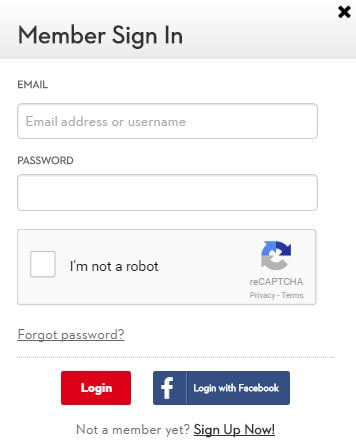
Additionally, Fab incorporates social sharing widgets which allow shoppers to show off their potential purchases:
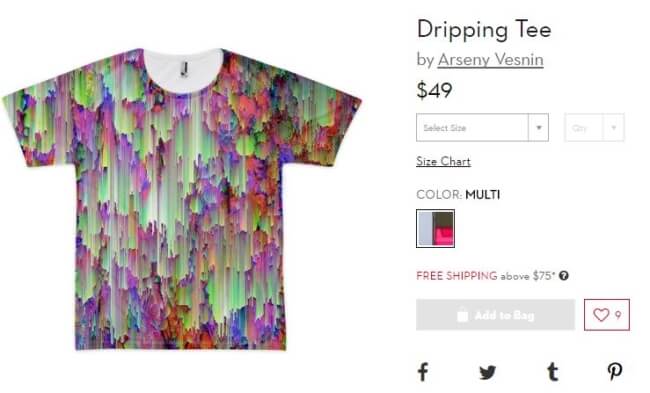
While these particular social shopping trends have been a long-time coming, bear in mind that one-click orders and social stores are quickly becoming expectations of modern buyers versus exceptions to the norm. Sooner rather than later, brands who fail to embrace social integration and simplified purchasing may be in danger of turning off potential business.
Social shopping is rooted in the power of User Generated Content. Time and time again, UGC has proven itself to be a marketing powerhouse when it comes to building trust and sealing the deal with skeptics. From five times higher conversion rate to the sheer fact that UGC allows your customers to do the marketing legwork on your behalf, there’s a reason why today’s brands are taking the necessary steps to encourage and curate interaction in their followers’ social feeds.
Think about it.
Real people want to see products in action.
Real people want to read reviews and understand the in’s and out’s of a product before they click the “Buy” button.
In short, the most buzzworthy content isn’t always that which you’ll create yourself. Encouraging and leveraging UGC is becoming a must-do in a crowded eCommerce space. Luckily, UGC takes many shapes and forms, all of which can be considered fair game for just about any brand.
Check out how Apart uses Flowbox’s visual commerce platform to display pictures shared by customers on social media to enhance their eCommerce website’s appeal.

When the user clicks on each customer photo, they can see which product is featured in the picture and buy it with a click.
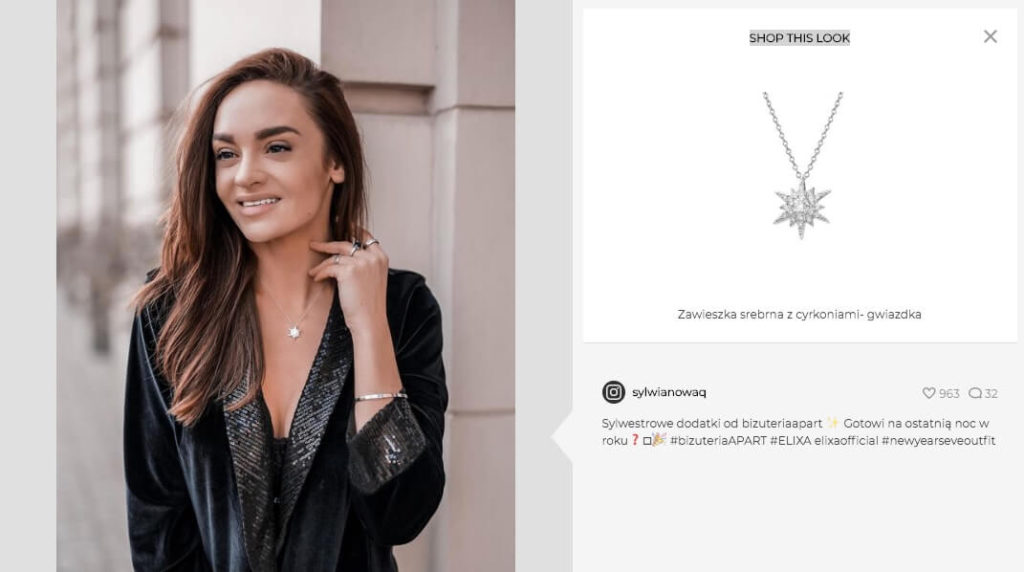
In terms of social shopping trends, the popularity of shoppable Instagram pages continues to boom. This should be no surprise given the noted tendency for mobile users to be serial shoppers; likewise, these same shoppers are more than happy to spend via social. Check out these customer photo examples.
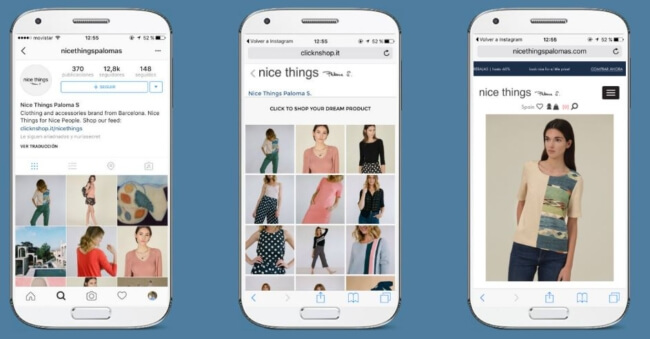
Likewise, today’s brands are showing off their products through hashtags and subsequently tagging customer photos. This represents a win-win situation for brands looking to engage their satisfied customers, create a sense of loyalty and provide their products with a real-world setting. Check out this example from Nice Things:

Social shopping is all about creating an experience. That is, providing opportunities for your customers to buy but also giving them some sort of stake in your product and service. This experience, from the front-end of your funnel to the checkout counter and back, will ultimately set brands apart. UGC provides the perfect avenue to giving that experience a more personal touch.
Ready to give UGC a go?
These social shopping trends may seem like a lot to digest; however, the principles of these trends are pretty straightforward.
The Customer Comes First – This may seem incredibly cliche, but it’s perhaps truer than it’s ever been. Today’s social shopping trends are sending a loud and clear message: the easier you make life for your customers, the better. The emergence of recommendations via chatbots and one-click shopping are clear indicators that today’s shoppers want a simpler route to their favorite products, not a lengthy opt-in process or an endless chase.
There’s Power in Personalization – The more that technology evolves to automate the buying process, the more our customers crave personalization. This may seem ironic at a glance; however, this lends truth to the fact that shopping is a social experience. It’s a conversation that goes back and forth versus a one-way street. Brands must, therefore, make the shopping experience, either through UGC or recommendations, as personalized as possible. In other words, it pays to understand your customers through collecting data and spending time with them via social.
Forget the Sales Pitch – Finally, the aforementioned social shopping trends prove that social media and eCommerce are becoming more and more intertwined. As a result, brands should strive to be less aggressive when selling via social. For example, recommendations and social offers should be framed as a helpful hand, not a sales pitch.
With the myriad of social shopping trends emerging, there are plenty of options on the table for marketers looking to engage their audiences. From the evolving platforms of Messenger marketing and chatbots to the tried-and-tested principles of encouraging UGC, the social aspect of shopping will remain a staple of eCommerce for years to come.
Which social shopping trends do you feel have the most potential? On the flip side, do you think any of these particular trends will be short-lived? Share your thoughts in the comments below to let us know where you think social shopping is headed.